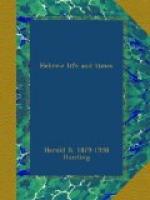Nehemiah’s Time | Our Own Time | a. Walls around the city. | a. ___________________________ | b. Robbers, and enemies such as | b. ___________________________ Sanballat. | | c. The poor and enslaved people. | c. ___________________________ | d. Nehemiah. | d. ___________________________
CHAPTER XXIV
HYMN AND PRAYER BOOKS FOR THE NEW WORSHIP
We have seen that a new kind of public worship of God had been growing up among the Hebrews, beginning with the time when the prophets began to condemn the misuse of the old animal sacrifices. The new worship consisted chiefly of prayer. We have seen how the exiles in Babylon began to come together on the Sabbath days to study the law and other sacred writings, and also for prayer. Those exiles who returned to Judaea brought this custom with them. Special buildings, called synagogues, were erected in Judaea as well as wherever there were faithful Jews in other lands. These synagogues rather than the temple gradually came to be the real home of the Jewish religion even in Jerusalem itself. The chief part of the synagogue service was always the study of the Scriptures. But prayer was also given an important place.
In the temple also, after it was rebuilt, public prayer was regarded as very important—even if not quite so important as the regular burnt-offerings. There were also prayer-hymns, sung by the people and by special choirs.
=Making hymnals and prayer books.=—In our churches, to-day, we could scarcely conduct our services without the hymn books scattered through the pews. In some denominations there is a prayer book, which is considered just as necessary as the book of hymns. In those ancient synagogues and in the temple service the Jews found such books needful. Had we gone into one of their meetings, we would not indeed have found a book waiting for us in the seat or handed to us by the usher. The art of printing was unknown. Books could not be purchased cheaply by the hundred. Each copy had to be written out by hand with pen and ink on a roll of papyrus. But we would probably have discovered that the leader of the worship had a book of prayers and hymns before him. He would read them, line by line, each Sabbath for the others to memorize. To make this task of memorization easier many of the Jewish hymns were written in acrostic form—that is, each line or stanza began with a different letter in the order of the Hebrew alphabet.
HYMN AND PRAYER BOOKS IN THE BIBLE
Our book of Psalms is a collection of smaller collections of just such hymns and prayers to be used in worship. Each one of these smaller collections came out of some synagogue or group of synagogues, or was prepared by the members of one of the choirs who led the worship in the temple. By studying these we may learn something about how they were used.




